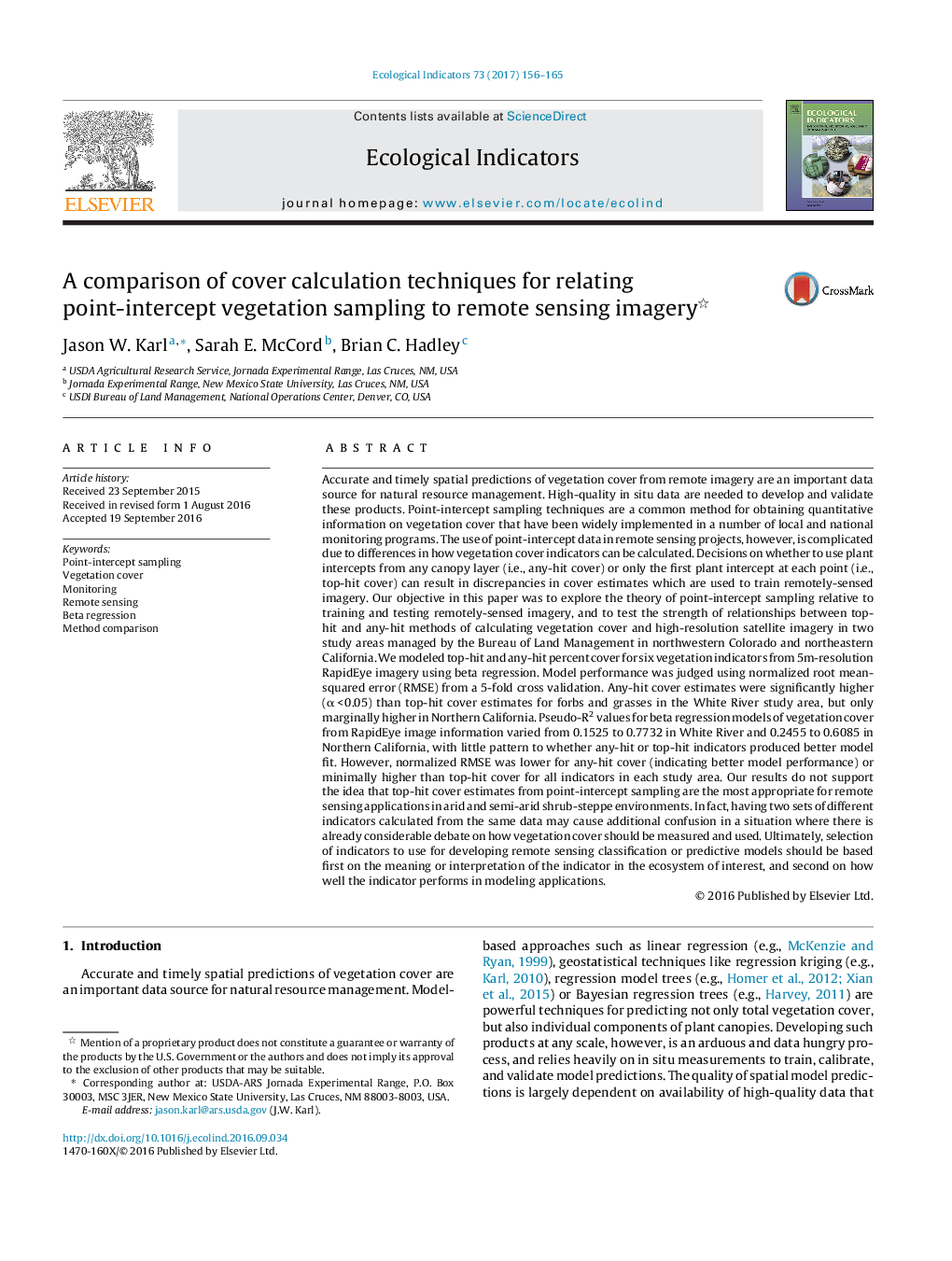| کد مقاله | کد نشریه | سال انتشار | مقاله انگلیسی | نسخه تمام متن |
|---|---|---|---|---|
| 6292547 | 1617129 | 2017 | 10 صفحه PDF | دانلود رایگان |
عنوان انگلیسی مقاله ISI
A comparison of cover calculation techniques for relating point-intercept vegetation sampling to remote sensing imagery
ترجمه فارسی عنوان
مقایسه تکنیک های محاسبات پوشش برای نمونه گیری از پوشش گیاهی نقطه ای به تصاویر تصویربرداری از راه دور
دانلود مقاله + سفارش ترجمه
دانلود مقاله ISI انگلیسی
رایگان برای ایرانیان
کلمات کلیدی
نمونه برداری از نقطه، پوشش گیاهی، نظارت بر، سنجش از دور، رگرسیون بتا، مقایسه روش،
موضوعات مرتبط
علوم زیستی و بیوفناوری
علوم کشاورزی و بیولوژیک
بوم شناسی، تکامل، رفتار و سامانه شناسی
چکیده انگلیسی
Accurate and timely spatial predictions of vegetation cover from remote imagery are an important data source for natural resource management. High-quality in situ data are needed to develop and validate these products. Point-intercept sampling techniques are a common method for obtaining quantitative information on vegetation cover that have been widely implemented in a number of local and national monitoring programs. The use of point-intercept data in remote sensing projects, however, is complicated due to differences in how vegetation cover indicators can be calculated. Decisions on whether to use plant intercepts from any canopy layer (i.e., any-hit cover) or only the first plant intercept at each point (i.e., top-hit cover) can result in discrepancies in cover estimates which are used to train remotely-sensed imagery. Our objective in this paper was to explore the theory of point-intercept sampling relative to training and testing remotely-sensed imagery, and to test the strength of relationships between top-hit and any-hit methods of calculating vegetation cover and high-resolution satellite imagery in two study areas managed by the Bureau of Land Management in northwestern Colorado and northeastern California. We modeled top-hit and any-hit percent cover for six vegetation indicators from 5m-resolution RapidEye imagery using beta regression. Model performance was judged using normalized root mean-squared error (RMSE) from a 5-fold cross validation. Any-hit cover estimates were significantly higher (α < 0.05) than top-hit cover estimates for forbs and grasses in the White River study area, but only marginally higher in Northern California. Pseudo-R2 values for beta regression models of vegetation cover from RapidEye image information varied from 0.1525 to 0.7732 in White River and 0.2455 to 0.6085 in Northern California, with little pattern to whether any-hit or top-hit indicators produced better model fit. However, normalized RMSE was lower for any-hit cover (indicating better model performance) or minimally higher than top-hit cover for all indicators in each study area. Our results do not support the idea that top-hit cover estimates from point-intercept sampling are the most appropriate for remote sensing applications in arid and semi-arid shrub-steppe environments. In fact, having two sets of different indicators calculated from the same data may cause additional confusion in a situation where there is already considerable debate on how vegetation cover should be measured and used. Ultimately, selection of indicators to use for developing remote sensing classification or predictive models should be based first on the meaning or interpretation of the indicator in the ecosystem of interest, and second on how well the indicator performs in modeling applications.
ناشر
Database: Elsevier - ScienceDirect (ساینس دایرکت)
Journal: Ecological Indicators - Volume 73, February 2017, Pages 156-165
Journal: Ecological Indicators - Volume 73, February 2017, Pages 156-165
نویسندگان
Jason W. Karl, Sarah E. McCord, Brian C. Hadley,
